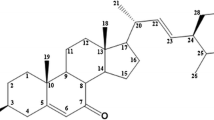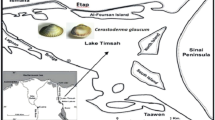Abstract
Our previous investigation revealed that 80% methanolic extract of the red alga Polysiphonia morrowii has significant antiviral activities against fish pathogenic viruses, infectious hematopoietic necrosis virus (IHNV) and infectious pancreatic necrosis virus (IPNV). The present study was conducted to identify compounds attributed for its antiviral activities and investigate their antiviral activities against IHNV and IPNV. Activity-guided fractionation for 80% methanolic extract of Polysiphonia morrowii using a cell-based assay measuring virus-induced cytopathic effect (CPE) on cells yielded a 90% methanolic fraction, which showed the highest antiviral activity against both viruses among fractions yielded from the extract. From the fraction, two bromophenols were isolated and identified as 3-bromo-4,5-dihydroxybenzyl methyl ether (1) and 3-bromo-4,5-dihydroxybenzaldehyde (2) based on spectroscopic analyses. For both compounds, the concentrations to inhibit 50% of flounder spleen cell (FSP cell) proliferation (CC50) and each viral replication (EC50) were measured. In the pretreatment test, 3-bromo-4,5-dihydroxybenzyl methyl ether (1) and 3-bromo-4,5-dihy-droxybenzaldehyde (2) exhibited significant antiviral activities showing selective index values (SI = CC50/EC50) of 20 to 42 against both IHNV and IPNV. In direct virucidal test, 3-bromo-4,5-dihydroxybenzyl methyl ether (1) showed significant antiviral activités against both viruses while 3-bromo-4,5-dihydroxybenzaldehyde (2) was significantly effective against only IHNV. Although antiviral efficacies of both compounds against IHNV and IPNV were lower than those of ribavirin used as a positive control, our findings suggested that the red alga Polysiphonia morrowii and isolated two bromophenols may have potential as a therapeutic agent against fish viral diseases.
Similar content being viewed by others
References
Biering, E., S. Villoing, I. Sommerset, and K.E. Christie. 2005. Update on viral vaccines for fish. Dev. Biol. 121, 97–113.
Chen, J.L., W.H. Gerwick, R. Schatzman, and M. Laney. 1994. Isorawsonol and related IMP dehydrogenase inhibitors from the tropical green alga Avarainvillea rawsonii. J. Nat. Prod. 57, 947–952.
Faulkner, D.J. 2000. Marine natural products. Nat. Prod. Rep. 17, 7–55.
Fu, X., F.J. Schmitz, M. Govindan, S.A. Abbas, K.M. Hanson, P.A. Horton, P. Crews, M. Lanley, and R.C. Schatzman. 1995. Enzyme inhibitors: new and known polybrominated phenols and diphenyl ethers from four Indo-Pacific Dysidea sponges. J. Nat. Prod. 58, 1384–1391.
Han, L., N. Xu, J. Shi, X. Yan, and C. Zeng. 2005. Isolation and pharmacological activities of bromophenols from Rhodomela confervoides. Chin. J. Ocean. Limn. 23, 226–229.
Hsuan, S.L., S.C. Chang, S.Y. Wang, T.L. Liao, T.T. Jong, M.S. Chien, W.C. Lee, S.S. Chen, and J.W. Liao. 2009. The cytotoxicity to leukemia cells and antiviral effects of Isatis indigotica extracts on pseudorabies virus. J. Ethnopharmacol. 123, 61–67.
Hudson, J.B., E.A. Graham, and M.F. Simpson. 1988. The efficacy of amantadine and other antiviral compounds against two salmonid viruses in vitro. Antiviral Res. 9, 379–385.
Jashes, M., M. Gonzalez, M. Lopez-Lastra, E. De Clercq, and A. Sandino. 1996. Inhibitors of infectious pancreatic necrosis virus (IPNV) replication. Antiviral Res. 29, 309–312.
Jason, D.G. and C.E. Cameron. 2006. Mechanisms of action of ribavirin against distinct viruses. Rev. Med. Virol. 16, 37–48.
Je, J.Y., C.B. Ahn, M.J. Oh, and S.Y. Kang. 2009. Antioxidative activity of a red seaweed Polysiphonia morrowii extract. Food Sci. Biotechnol. 18, 124–129.
Kamei, Y. and M. Aoki. 2007. A chlorophyll c2 analogue from the marine brown alga Eisenia bicyclis inactivates the infectious hematopoietic necrosis virus, a fish rhabdovirus. Arch. Virol. 152, 861–869.
Kang, S.Y., S.R. Kim, and M.J. Oh. 2008. In vitro antiviral activities of Korean Marine algae extracts against fish pathogenic infectious hematopoietic necrosis virus and infectious pancreatic necrosis virus. Food Sci. Biotechnol. 17, 1074–1078.
Kang, S.Y., M.J. Oh, and J.A. Shin. 2005. Antimicrobial activities of Korean marine algae against fish pathogenic bacteria. J. Fish. Pathol. 18, 147–156.
Kim, M.S., I.K. Lee, and S.M. Boo. 1994. Morphological studies of the red alga Polysiphonia morrowii Harvey on the Korean Coast. Kor. J. Phycol. 9, 185–192.
Kujumgiev, A., I. Tsvetkova, Y. Serkedjieva, V. Bankova, R. Christov, and S. Popov. 1999. Antibacterial, antifungal and antiviral activity of propolis of different geographic origin. J. Ethnopharmacol. 64, 235–240.
Kurata, K., K. Taniguchi, K. Takashima, I. Hayashi, and M. Suzuki. 1997. Feeding-deterrent bromophenols from Odonthalia corymbifera. Phytochemistry 45, 485–487.
Kurihara, H., T. Mitani, J. Kawabata, and K. Takahashi. 1999. Inhibitory potencies of bromophenols from Rhodomelaceae algae against α-glucosidase activity. Fish. Sci. 65, 300–303.
Li, K., X.M. Li, N.Y. Ji, and B.G. Wang. 2008. Bromophenols from the marine red alga Polysiphonia urceolata with DPPH radical scavenging activity. J. Nat. Prod. 71, 28–30.
Nishizawa, T., S. Kinoshita, and M. Yoshimizu. 2005. An approach for genogrouping of Japanese isolates of aquabirnaviruses in a new genogroup, VII, based on the VP2/NS junction region. J. Gen. Virol. 86, 1973–1978.
Park, H.J., M. Kurokawa, K. Shiraki, N. Nakamura, J.S. Choi, and M. Hattori. 2005. Antiviral activity of the marine alga Symphyocladia latiuscula against herpes simplex virus (HSV-1) in vitro and its therapeutic efficacy against HSV-1 infection in Mice. Biol. Pharm. Bull. 28, 2258–2262.
Reno, P.W. 1999. Infectious pancreatic necrosis and associated aquatic birnaviruses. Vol. 3, pp. 1–55. In P.T.K. Woo and D.W. Bruno (eds.), Fish Diseases and Disorders, CABI Publishing, NY, USA.
Samuelsen, O.B., A.H. Nerland, T. Jorgensen, M.B. Schroder, T. Svasand, and O. Bergh. 2006. Viral and bacterial diseases of Atlantic cod Gadus morhua, their prophylaxis and treatment: a rewiew. Dis. Aquat. Org. 71, 239–254.
Shoeib, N.A., M.C. Bibby, G. Blunden, P.A. Linley, D.J. Swaine, R.T. Wheelhouse, and C.W. Wright. 2004. In-vitro cytotoxic activities of the major bromophenols of the red alga Polysiphonia lanosa and some novel synthetic isomers. J. Nat. Prod. 67, 1445–1449.
Sinha, S., N. Cheshenko, R.I. Lehrer, and B.C. Herold. 2003. NP-1, a rabbit (alpha)-defensin, prevents the entry and intercellular spread of herpes simplex virus type 2. Antimicrob. Agents Chemother. 47, 494–500.
Suzuki, S., M. Kamakura, and R. Kusuda. 1998. Isolation of birnavirus from Japanese Pearl oyster Pinctada fucata. Fish. Sci. 64, 342–343.
Suzuki, S. and M. Nojima. 2000. Distribution of a marine birnavirus in wild molluscan shellfish species from Japan. Fish Pathol. 34, 121–126.
Thompson, K.D. 1998. Antiviral activity of Viracea against acyclovir susceptible and acyclovir resistant strains of herpes simplex virus. Antiviral Res. 39, 55–61.
Wall, M.E., M.C. Wani, G. Manikumar, H. Taylor, T.J. Hughes, K. Gaetano, W.H. Gerwick, A.T. McPhail, and D.R. McPhail. 1989. Plant antimutagenic agents, 7. Structure and antimutagenic properties of cymobarbatol and 4-isocymobarbatol, new cymopols from green alga (Cymopolia barbata). J. Nat. Prod. 52, 1092–1099.
Wiemer, D.F., D.D. Idler, and W. Fenical. 1991. Vidalols A and B, new anti-inflammatory bromophenols from the Caribbean marine red alga Vidalia obtusaloba. Experientia 47, 851–853.
Wolf, K. 1988. Infectious hematopoietic necrosis and infectious pancreatic necrosis. pp. 83–157. In K. Wolf (ed.), Fish viruses and fish viral diseases. Cornell University Press, Ithaca, NY, USA.
Xu, N., X. Fan, X. Yan, X. Li, R. Niu, and C.K. Tseng. 2003. Antibacterial bromophenols from the marine red alga Rhodomela confervoides. Phytochemistry 62, 1221–1224.
Author information
Authors and Affiliations
Corresponding author
Rights and permissions
About this article
Cite this article
Kim, SY., Kim, S.R., Oh, MJ. et al. In Vitro antiviral activity of red alga, Polysiphonia morrowii extract and its bromophenols against fish pathogenic infectious hematopoietic necrosis virus and infectious pancreatic necrosis virus. J Microbiol. 49, 102–106 (2011). https://doi.org/10.1007/s12275-011-1035-z
Received:
Accepted:
Published:
Issue Date:
DOI: https://doi.org/10.1007/s12275-011-1035-z




